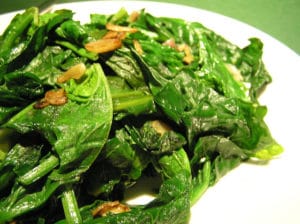Cornucopia’s Take: The USDA recently retested conventional spinach for pesticides, having last tested it in 2008. In the last decade there has been a sharp increase in pesticide residue on the crop. USDA samples show more pesticides by weight on spinach than any other crop, including up to 16 pesticides and metabolites of pesticides found on each sample. Permethrin, linked to ADHD in children, was among the most alarming residue found—and on 75% of the samples. Spinach also appears to be particularly “good” at taking up DDT residue left in the soil, a pesticide banned in the 70s. DDT residue was found on half of the spinach samples.
EU-Banned Pesticide Found on Spinach, Now Second on Dirty Dozen™
EWG
 |
Spinach is packed with nutrients, a staple for healthy eating during the winter and spring. But new federal data shows that conventionally grown spinach has more pesticide residues by weight than all other produce tested, with three-fourths of samples tested contaminated with a neurotoxic bug killer that is banned from use on food crops in Europe.
The latest tests by the Department of Agriculture showed a sharp increase in pesticide residues on non-organic spinach since the crop was last tested eight years ago. Based on the USDA tests, EWG’s Shopper’s Guide to Pesticides in Produce™ now ranks spinach second on the Dirty Dozen™ list of fruits and vegetables with the most pesticides – a significant jump from last year, when it ranked eighth.
The USDA recently published results of a pesticide analysis for 683 conventionally grown spinach samples collected in 2015. These samples contained far more pesticides by weight than all other crops tested, and double or more the amount found on all other Dirty Dozen crops.
The tests detected an average of almost seven pesticides on every conventionally grown spinach sample collected in 2015, with a maximum of 16 different pesticides or breakdown products on a single sample. Four pesticides – one insecticide and three fungicides – were responsible for the bulk of the residues detected on spinach.
Seventy-five percent of the samples contained residues of permethrin, a neurotoxic insecticide. At high doses, permethrin overwhelms the nervous system and causes tremors and seizures.
But several studies also find a link between lower-level exposure to permethrin-type insecticides and neurological effects in children. In one study, children with detectable permethrin residues in their urine were twice as likely to be diagnosed with ADHD as children with non-detectable levels of the pesticide.
Besides its use as a pesticide, permethrin is also used to kill head lice and is embedded in mosquito-repellent fabrics. The Environmental Protection Agency is currently assessing the health risks of permethrin and related pesticides on food, with its final report due later this year. Since 2000, Europe has not permitted any permethrin to be used on food crops.1
Three other previously undetected fungicides – mandipropam, fluopicolide and ametoctradin, which are used to kill mold and mildew – were found at relatively high concentrations on spinach samples. These were not found in earlier in spinach tests and are relatively uncommon on other produce.
Most of the pesticides found on conventional spinach samples are sanctioned as legal and safe by the EPA. Only eight samples had concentrations that violated the EPA’s maximum pesticide residue limits. The USDA found 206 samples that had residues of pesticides that are prohibited for use on spinach, but are legal on other food crops.
DDT, a pesticide long banned in the U.S., also showed up on spinach and very few other crops. Residues of DDT and its breakdown products were found on half of spinach samples.
DDT breakdown products were detected in much lower concentration than the other spinach pesticides, but are far more toxic to people. Although DDT was banned in the 1970s, residues remain in the soil and are picked up by spinach grown today.
Spinach sold in U.S. grocery stores is mostly grown domestically, with 60 percent coming from California. Arizona, New Jersey and Texas, and foreign imports making up the rest.
Consumer tips
- Eat lots of vegetables and fruits. Spinach is a great source of vitamin A, folate and vitamin C, and it’s a good source of vitamin E and potassium.
- Buy organic spinach and other leafy greens. The USDA hasn’t tested pesticide levels on kale and collard greens since 2008, but some highly toxic pesticides can still be used legally on leafy greens like kale and collard greens.
- Wash spinach thoroughly. California tests of unwashed spinach found higher concentrations of pesticides. The USDA washed all of the spinach samples vigorously before testing. The USDA has also previously detected pesticides on frozen and canned spinach, suggesting that washing and cooking reduces pesticide levels but does not eliminate them.
1 European Commission, Permethrin. Directorate General for Agriculture, 2000; 6522/VI/99-Final, DG VI-B.II-1 13. Available at ec.europa.eu/food/plant/pesticides/eu-pesticides-database/public/?event=activesubstance.ViewReview&id=55

